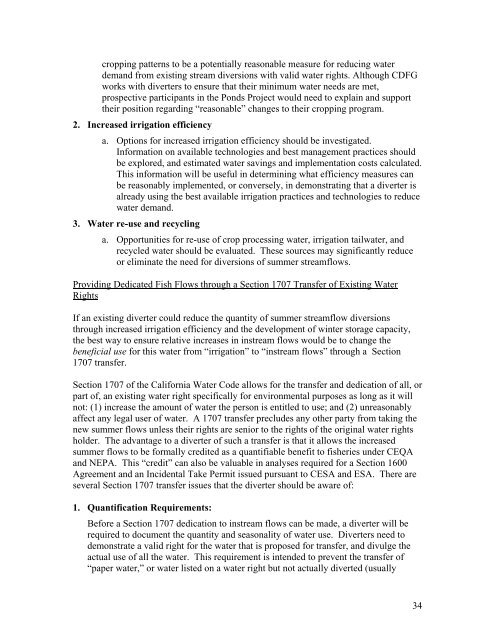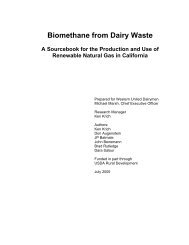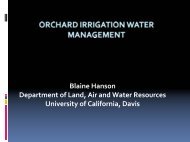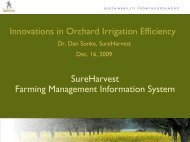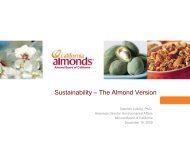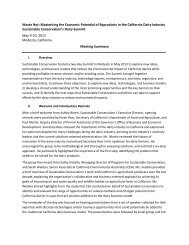THE PONDS PROJECT - Sustainable Conservation
THE PONDS PROJECT - Sustainable Conservation
THE PONDS PROJECT - Sustainable Conservation
You also want an ePaper? Increase the reach of your titles
YUMPU automatically turns print PDFs into web optimized ePapers that Google loves.
cropping patterns to be a potentially reasonable measure for reducing water<br />
demand from existing stream diversions with valid water rights. Although CDFG<br />
works with diverters to ensure that their minimum water needs are met,<br />
prospective participants in the Ponds Project would need to explain and support<br />
their position regarding “reasonable” changes to their cropping program.<br />
2. Increased irrigation efficiency<br />
a. Options for increased irrigation efficiency should be investigated.<br />
Information on available technologies and best management practices should<br />
be explored, and estimated water savings and implementation costs calculated.<br />
This information will be useful in determining what efficiency measures can<br />
be reasonably implemented, or conversely, in demonstrating that a diverter is<br />
already using the best available irrigation practices and technologies to reduce<br />
water demand.<br />
3. Water re-use and recycling<br />
a. Opportunities for re-use of crop processing water, irrigation tailwater, and<br />
recycled water should be evaluated. These sources may significantly reduce<br />
or eliminate the need for diversions of summer streamflows.<br />
Providing Dedicated Fish Flows through a Section 1707 Transfer of Existing Water<br />
Rights<br />
If an existing diverter could reduce the quantity of summer streamflow diversions<br />
through increased irrigation efficiency and the development of winter storage capacity,<br />
the best way to ensure relative increases in instream flows would be to change the<br />
beneficial use for this water from “irrigation” to “instream flows” through a Section<br />
1707 transfer.<br />
Section 1707 of the California Water Code allows for the transfer and dedication of all, or<br />
part of, an existing water right specifically for environmental purposes as long as it will<br />
not: (1) increase the amount of water the person is entitled to use; and (2) unreasonably<br />
affect any legal user of water. A 1707 transfer precludes any other party from taking the<br />
new summer flows unless their rights are senior to the rights of the original water rights<br />
holder. The advantage to a diverter of such a transfer is that it allows the increased<br />
summer flows to be formally credited as a quantifiable benefit to fisheries under CEQA<br />
and NEPA. This “credit” can also be valuable in analyses required for a Section 1600<br />
Agreement and an Incidental Take Permit issued pursuant to CESA and ESA. There are<br />
several Section 1707 transfer issues that the diverter should be aware of:<br />
1. Quantification Requirements:<br />
Before a Section 1707 dedication to instream flows can be made, a diverter will be<br />
required to document the quantity and seasonality of water use. Diverters need to<br />
demonstrate a valid right for the water that is proposed for transfer, and divulge the<br />
actual use of all the water. This requirement is intended to prevent the transfer of<br />
“paper water,” or water listed on a water right but not actually diverted (usually<br />
34


